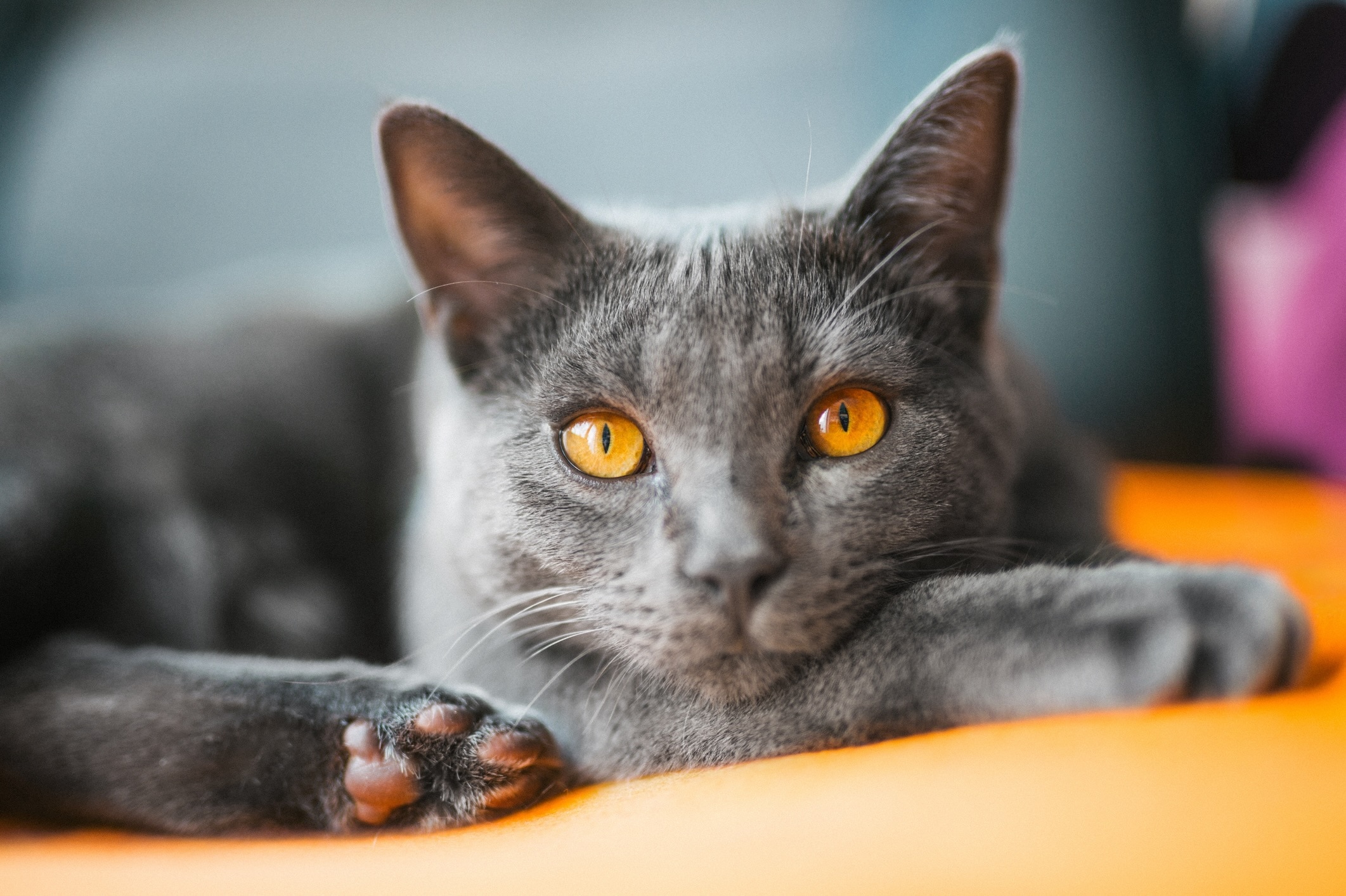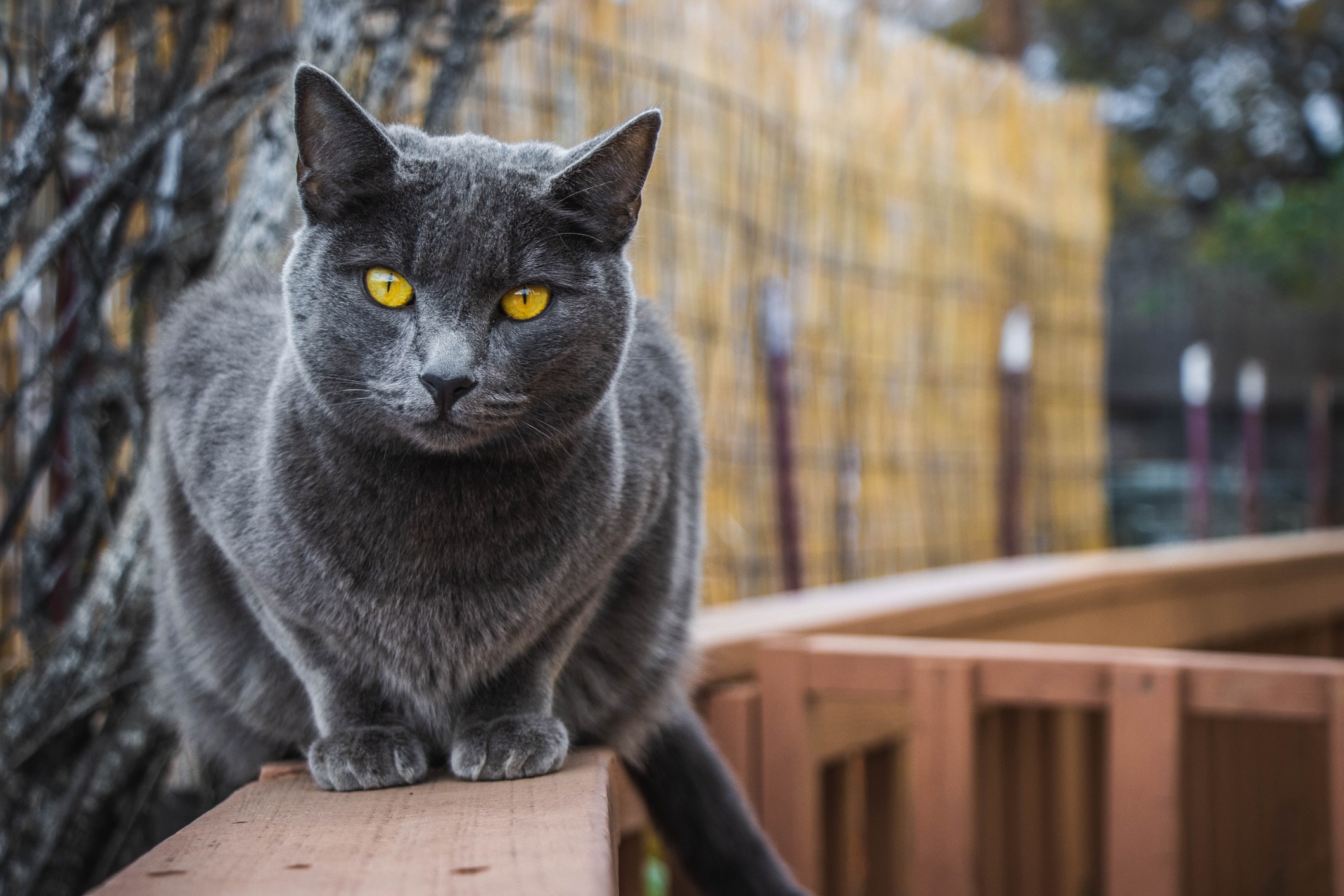Chartreux
cunfek/iStock / Getty Images Plus via Getty Images
Meet the Chartreux (pronunciation, “shaar-troos”): A gray-blue cat of French origin with a soft, wooly coat rivaling the luxurious Spanish wool called la pile des Chartreux, which is said to have inspired their name. The Chartreux cat’s unique color comes from a genetic dilution of black pigment.
Beneath that plush blue fur, Chartreux cats are surprisingly muscular with a sturdy build. Standing 9–11 inches tall, the Chartreux cat breed can weigh 6–12 pounds.
Caring for a Chartreux
Out of the 40-plus recognized cat breeds, the Chartreux is one of a few natural cat breeds, meaning the breed developed without intentional breeding by humans. Their au naturel blue coat and eyes, which range from copper to gold, have charmed cat-lovers for centuries. Plus, these beauties don't require high-maintenance grooming.
The Chartreux cat’s calm demeanor and quiet nature make them one of the sweetest short-haired breeds, ideal buddies for all sorts of companions (young, old, or furry).
Their past as mousers suggests a playful side that might just go wild with interactive toys and plenty of cat furniture to scale.
Chartreux Health Issues

Centuries of natural development give the Chartreux breed a strong genetic foundation.
Responsible breeders who test their cats for genetic conditions before breeding help lower the risk of genetic health problems in kittens. Therefore, the Chartreux cat breed tends to be healthy with an average lifespan of 12–15 years.
That said, it’s still a good idea to consider pet insurance for your Chartreux kitten. Pet insurance can help cover preventative care and unexpected experiences due to common cat illnesses, such as diarrhea or upper respiratory infections.
Patellar Luxation
Patellar luxation is a congenital condition where the kneecap sits too loosely in its groove in the thigh bone and slips out. Patellar luxation can cause limping or lameness in your cat.
In mild cases, your vet may recommend joint supplements to help prevent arthritis, but surgery may be needed in serious cases. Weight management can help prevent the condition from worsening.
Obesity
All cats are at risk of eating too much and/or exercising too little, leading to weight gain and obesity. Talk to your vet about your cat’s ideal caloric intake as well as the signs of a healthy body condition.
Extra weight can lead to all sorts of issues in cats, including:
-
Orthopedic issues, such as hip dysplasia
Dental Disease
Just like us, cats can develop plaque and tartar buildup on their teeth. This can lead to inflamed gums, bad breath, and more serious dental problems.
To prevent dental disease in your cat, vets recommend brushing cats’ teeth with a cat-specific toothpaste and toothbrush a few times a week. Dental treats, like Greenies™, can also help.
Regular vet checkups are crucial, too. Your vet will examine your cat's teeth and recommend professional cleanings when needed.
What To Feed a Chartreux
All cats are obligate carnivores, which means they need a diet based on animal proteins. To ensure your Chartreux gets all the essential nutrients they need, choose a commercial cat food that meets the recommendations set by the Association of American Feed Control Officials (AAFCO).
Chartreux kittens should eat kitten food or food formulated for all life stages. These foods provide extra nutrients needed for growth. Adult Chartreux cats should transition to an adult food. As your Chartreux ages, your veterinarian may recommend a senior-specific diet.
Your veterinarian will help you choose the best food for your cat.
How To Feed a Chartreux
Chartreux cats are mousers at heart. To mimic their natural eating patterns, offer your Chartreux at least two meals a day or consider dividing their food into smaller, more frequent portions.
An automatic feeder can be a convenient way to schedule multiple meals, even when you’re away. Or, consider using a food puzzle or a mouse toy for their meals to help satisfy their hunting instincts.
How Much Should You Feed a Chartreux?
The ideal portion of food for your Chartreux is based on their daily calorie needs. This can be calculated by your vet and depends on factors such as age, weight (current and ideal), health, and activity level.
It’s always best to schedule a vet appointment to learn how much to feed your cat. In the meantime, the feeding guidelines on your cat food packaging can serve as a reference.
Nutritional Tips for Chartreux Cats
Healthy cats that eat a well-balanced cat food shouldn’t need meal supplements. However, talk to your vet if you think your cat could benefit from a feline supplement, especially as your Chartreux ages or if they develop a health condition.
Behavior and Training Tips for Chartreux Cats
Chartreux Cat Personality and Temperament

The Chartreux cat might be mighty in looks, but they are big, mellow fur babies. This makes them a great fit for all kinds of cat lovers, including families with children and other pets.
To nurture the best relationships, introduce Chartreux cats to new family members or environments slowly, and teach children how to interact with their pet gently and respectfully.
Chartreux cats remain playful throughout their lives. They particularly enjoy games that channel their hunting instincts, like stalking and pouncing, according to the Chartreux Cat Club UK. They are also affectionate companions that shower their people with attention.
Chartreux Cat Behavior
Chartreux cats have subtle meows, if they meow at all. It’s in their nature to be undemanding. Their meows are often replaced by soft chirps and expressive body language.
But don’t mistake their quiet demeanor for a lack of interest in play or affection. Without enough social and physical activity, they can get into mischief just like any other cat. However, Chartreux cats are more likely to nudge you with a paw or present a toy before resorting to unwanted behaviors like scratching furniture.
Chartreux Cat Training
Intelligent and curious Chartreux cats can learn all sorts of new things. Positive reinforcement training (rewarding your cat for wanted behaviors) makes clicker training a fun bonding experience for you and your cat as they learn new tricks and cues.
Fun Activities for Chartreux Cats
-
Sunbathing on a window perch
-
Birdwatching from a catio
-
Cuddling
-
Exploring new surroundings
-
Playing with housemates
Chartreux Grooming Guide
Looking for a low-maintenance kitty? The smokey blue Chartreux may be an excellent choice. They don’t need much in the way of hair care, but like all cats, they should have their nails trimmed regularly and their teeth brushed a few times a week.
Skin Care
Chartreux cats generally don’t need special skin care. But if you bathe your cat, you might notice their fur is unique: They have a dense, plush undercoat and a water-resistant topcoat.
Regardless of bathing, regularly check your cat's skin for redness, flaking, or flea dirt (small black dots that look like pepper flakes).
Coat Care
Weekly brushing will do the trick to reduce shedding. Chartreux may need more frequent grooming sessions in the spring and fall.
Eye Care
While Chartreux cats' copper-colored eyes typically don't require special care, be on the lookout for signs of common cat eye problems, such as redness or unusual discharge.
Ear Care
Chartreux cats typically don't require routine ear cleaning. However, call your vet if you notice:
-
Foul odor from one or both ears
-
Discharge from the ears
-
Crusting or scabs around the ears
-
Pawing at the ears
-
Head shaking
These are all signs of a cat ear infection, which can typically quickly be treated with help from your veterinarian.
Considerations for Pet Parents
If you're looking for a calm and playful cat, the Chartreux might be a perfect fit for your family. They’re known for their plush blue coat and quiet demeanor (they rarely meow!).
Chartreux are relatively low-maintenance, requiring weekly brushing on top of routine dental and nail care.
While affectionate, they’re also natural-born hunters. You can keep them entertained with puzzles, cat furniture, and plenty of toys to chase and pounce on.
Chartreux FAQs
Is my cat a Russian Blue or a Chartreux?
Russian Blues and Chartreux cats share similar blue coats and body types, but their eye colors are the key giveaway between the two. Russian Blue cats have green eyes, while Chartreux cats have gold to copper eyes.
How much does a Chartreux cat cost?
A Chartreux kitten can cost $1,300–$1,700.
Are Chartreux cats cuddly?
Yes, many Chartreux cats enjoy cuddling with their people. While they are known for their gentle and easygoing nature, individual personalities can vary. Early socialization and gentle handling can encourage your Chartreux to be a cuddle buddy.
Do Chartreux like to be held?
Chartreux cats are known for their mellow personalities and often don’t mind being held. However, every cat is different. Be respectful of their body language, learn how to pick up a cat, and always put them down if they seem uncomfortable.
